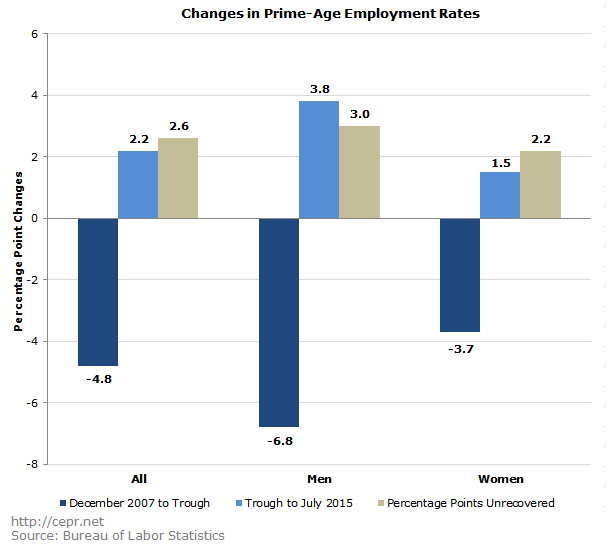August 11, 2015
Two months ago, CEPR released a report on changes in the prime-age employment rate since the beginning of the recession in December 2007. CEPR used the prime-age employment rate rather than the unemployment rate for a specific reason: in order to be counted as unemployed, a prospective worker must “have actively looked for work in the prior 4 weeks.” This means that if someone has been searching for work for a long period of time, but has become dissatisfied with their prospects and hasn’t applied for any jobs over the previous month, he or she is no longer counted as “unemployed.” Paradoxically, if enough workers become discouraged with their job prospects and give up their searches for work, the unemployment rate can fall even as the job market is weakening.
In order to correct for this and other problems, it’s best to analyze rates of employment rather than unemployment. However, if we look at the employment rate for the U.S. as a whole, we miss out on the changing age distribution of the population: if the population is aging, a greater percentage of the population may hit retirement age and willingly retire, which doesn’t imply a weaker job market. Conversely, if the population is becoming younger, a greater percentage of the population may enroll in high school or college; yet this tells us nothing about employment opportunities for those who want to work. A simple way to correct for a changing age distribution is to limit one’s analysis to the “prime-age” population (Americans aged 25 to 54). The most recent job figures show that 77.1 percent of all 25-to-54 year-olds were employed in July. This means that the labor market has made up just 2.2 out of the 4.8 percentage points of prime-age employment that were lost between December 2007 and September and October of 2011.*
When CEPR released the aforementioned paper on prime-age employment, we reported that “as of March 2015, men and women had seen nearly equivalent net employment losses since December 2007”—prime-age employment was down 2.5 percentage points for men and 2.4 percentage points for women. However, since then the prime-age employment rate has fallen 0.5 percentage points for men and has risen 0.2 percentage points for women. (Overall prime-age employment has dropped 0.1 percentage points.) This means that the prime-age employment rate for men is now 3.0 percentage points below its December 2007 level, while the prime-age employment rate for women is 2.2 percentage points lower, as can be seen in the graph below:

As can be seen, the main reason why the prime-age employment rate has fallen more for men than for women is because the initial drop in employment was more severe for men. The drop for men was about twice as great as the drop for women; and while men have experienced a stronger recovery than women, the net effect of the initial drop and subsequent recovery has been worse for men than for women.
Nonetheless, prime-age employment is down significantly for both. The labor market has recovered just 46 percent of the prime-age employment that was lost between December 2007 and late 2011. Achieving low employment rates for both men and women is hardly the best way to create gender equality in the economy. With prime-age employment down over two percentage points for both men and women, it’s clear that the recovery in the labor market still has a long way to go.
*The prime-age employment rate was 79.7 percent when the recession began in December 2007; it bottomed out at 74.9 percent in both September and October of 2011. Note that the prime-age employment rate fell to 74.8 percent in November 2010, but that this appears to be more of an anomaly than a true trough, since the rate was 75.0 percent in both October and December of that year.






